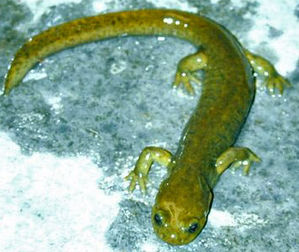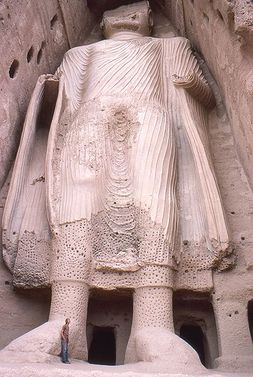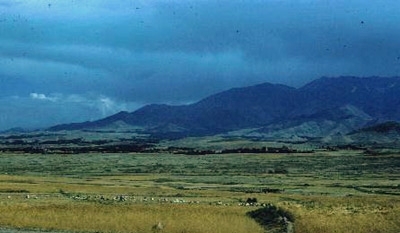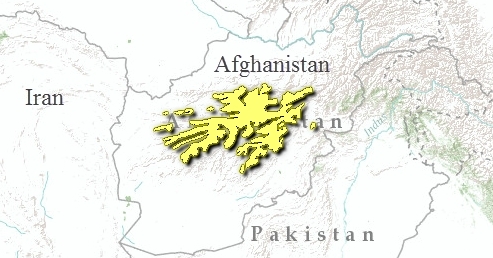Ghorat-Hazarajat alpine meadow
The Ghorat-Hazarajat alpine meadow is a large ecoregion of Afghanistan comprising approximately 25,700 square miles in land area. This ecoregion is classified in the Montane Grasslands and Shrublands biome. Vegetation at the higher altitudes is necessarily hardy, having to combat alternatively frost and drought.
The Critically Endangered Paghman Mountain salamander (Paradactylodon mustersi) is endemic to this ecoregion; moreover, its total population is estimated to no more than 2000 individuals. The survival of the salamanderis threatened by ongoing stream diversions, since the aquatic habitat of this taxon is restricted to a very small area of specialized coldwater habitat.
Contents
Location and general description
The Ghorat-Hazarajat alpine meadow is situated within Afghanistan's central highlands, being comprised of both high alpine meadow and steppe, as well as desert and lacustrine shoreline habitat. Vegetation at the higher altitudes of the ecoregion is hardy, having to combat alternatively frost and drought. At lower elevations, some portions are flooded with spring snowmelt. Areas that do not receive snowmelt runoff, and are alos of scant precipitation usually manifest scrub cover.
The southernmost portion of the Ghorat-Hazarajat alpine meadow ecoregion lies in the high mountains, representing the northern portion of the Zabul Province; here, in the south, the habitat is characterized by meadows, willows and certain buckthorn taxa.
Biodiversity features
 Paghman Mountain salamander. Source: Theodore Papenfuss/EOL There are a total of 190 recorded vertebrate species within the Ghorat-Hazarajat alpine meadow ecoregion. Endemic vertebrates in this ecoregion are comprised of a single species: the Critically Endangered Paghman Mountain salamander (Paradactylodon mustersi), whose total population is estimated to no more than 1000 to 2000 individuals. This salamander survives only in the cold water formed by glacial melt at higher elevations, and its total range does not exceed ten square kilometers.
Paghman Mountain salamander. Source: Theodore Papenfuss/EOL There are a total of 190 recorded vertebrate species within the Ghorat-Hazarajat alpine meadow ecoregion. Endemic vertebrates in this ecoregion are comprised of a single species: the Critically Endangered Paghman Mountain salamander (Paradactylodon mustersi), whose total population is estimated to no more than 1000 to 2000 individuals. This salamander survives only in the cold water formed by glacial melt at higher elevations, and its total range does not exceed ten square kilometers.
Native non-endemic special status mammals of the ecoregion are: the Near Threatened argali (Ovis ammon), the Vulnerable Asiatic black bear (Ursus thibetanus), the Near Threatened Euphrates jerboa (Allactaga euphratica), the Near Threatened European otter (Lutra lutra), the Vulnerable goitered gazelle (Gazella subguttarosa), the Near Threatened leopard (Panthera pardus), the Vulnerable marbled polecat (Vormela peregusna), the Near Threatened Screiber's long-fingered bat (Miniopterus schreibersii), the Endangered snow leopard (Panthera uncia) and the Near Threatened striped hyena (Hyaena hyaena).
Non-endemic threatened avian taxa consist of the Near Threatened ala shan redstart (Phoenicurus alashanicus), the Vulnerable beautiful nuthatch (Sitta formosa), the Near Threatened cinereous vulture (Aegypius monachus), the Endangered Egyptian vulture (Neophron percnopterus), the Vulnerable izu thrush (Turdus celaenops), the Near Threatened Japanese waxwing (Bombycillidae japonica), the Near Threatened laggar falcon (Falco jugger), the Vulnerable pale-backed pigeon (Columba eversmanni) and the Endangered rufous-backed bunting (Emberiza jankowskii).
Ancient history
 One of two sixth century AD Bamiyan Buddhas destroyed by the Taliban in 2001. Source: Wikimedia Commons. Human habitation is known to have been present in the more fertile valleys of present day Afghanistan at least 50,000 years before present, with some sedentary agriculture among the earliest on Earth. Relicts of theMesolithic, Neolithic, Bronze and Iron ages have been found in these meadows and valleys. Urban civilization in the region is noted as early as 3000 BC, at a locus slightly to the south at the ancient city of Mundigak. In the beginning of the first millennium BC, trade began to become more regular along the Northern Silk Road, bringing regular contact between the Greek and Pesian civilizations in the west and China in the east, this region of Afghanistan being a stopover. By around 550 BC, Achaemenid Persians overran the Medes civilization, annexing most of Afghanistan (Arachosia, Aria and Bactria). The tombstone of Darius I of Persia cites the Persian victories nearby by place name.
One of two sixth century AD Bamiyan Buddhas destroyed by the Taliban in 2001. Source: Wikimedia Commons. Human habitation is known to have been present in the more fertile valleys of present day Afghanistan at least 50,000 years before present, with some sedentary agriculture among the earliest on Earth. Relicts of theMesolithic, Neolithic, Bronze and Iron ages have been found in these meadows and valleys. Urban civilization in the region is noted as early as 3000 BC, at a locus slightly to the south at the ancient city of Mundigak. In the beginning of the first millennium BC, trade began to become more regular along the Northern Silk Road, bringing regular contact between the Greek and Pesian civilizations in the west and China in the east, this region of Afghanistan being a stopover. By around 550 BC, Achaemenid Persians overran the Medes civilization, annexing most of Afghanistan (Arachosia, Aria and Bactria). The tombstone of Darius I of Persia cites the Persian victories nearby by place name.
Alexander the Great led the Macedonian forces into the Afghanistan region circa 330 BC, subsequent to their defeat of Darius III of Persia at the Battle of Gaugamela. After the Macedonians ceded the entire Afghanistan region south of the Hindu Kush to the Mauryans of India, those Indian settlers established Buddhism and reigned south of the Hindu Kush until about 185 BC, at which time they were overthrown, leading to Greek reconquest of the region by the Greco-Bactrians.
Current status
The Ghorat-Hazarajat alpine meadow ecoregion has a conservation status of Vulnerable; moreover, it has been given a G200 designation, meaning that the ecoregion is considered a high priority in international conservation priority. The ecoregion also carries with it the designation PA1004, according to the World Wildlife Fund categorization.
Types and severity of threats
 Polish forces in Ghazni Province, 2009. Source: Obrony Narodowej Threats to the biota of this ecoregion include overgrazing, warfare and water extraction from the high elevation streams of the region. While warfare has subsided, until there is more stable peace in the region, warfare is a continuing threat to the ecosystems.
Polish forces in Ghazni Province, 2009. Source: Obrony Narodowej Threats to the biota of this ecoregion include overgrazing, warfare and water extraction from the high elevation streams of the region. While warfare has subsided, until there is more stable peace in the region, warfare is a continuing threat to the ecosystems.
With regard to water diversions, the survival of the Critically Endangered salamander Paradactylodon mustersi is threatened by ongoing and potential new stream diversions, since the aquatic habitat of this taxon is restricted to a very small area of specialized coldwater habitat. In addition, the martial atmosphere makes surveys of this salamander quite difficult.
Justification of ecoregion delineation
This ecoregion is located in a mountainous region of central Afghanistan. The boundaries were drawn according to Freitag’s (1971) map of natural vegetation (Plant). These boundaries correspond to the region classified as thornbush meadows and alpine grasslands.
References
- A.H.Dani and B.A.Litvinsky. 1996. The Kushano-Sasanian Kingdom. In: History of civilizations of Central Asia, Volume III. The crossroads of civilizations: A.D. 250 to 750. Litvinsky, B.A., ed., UNESCO Publishing ISBN 92-3-103211-9.
- H.Freitag. 1971. Studies in the natural vegetation of Afghanistan. Pages 89-106 in P. H. Davis, Harper, and I. C. Hedge, editors. Plant life of South-West Asia. The Botanical Society of Edinburgh, Edinburgh.
- C.Michael Hogan. 2007. Silk Road, North China. ed.A.Burnham. Megalithic Portal
- William Maley. 2009. The Afghanistan wars. Palgrave Macmillan. ISBN978-0-230-21313-5.
- Newsday. October 2001. Taliban massacres outlined for UN. Chicago Tribune.
- United Nations Environment Programme. 2008. Biodiversity profile of Afghanistan. Kabul, Afghanistan
- World Wildlife Fund. 2010. Ghorat-Hazarajat alpine meadow

